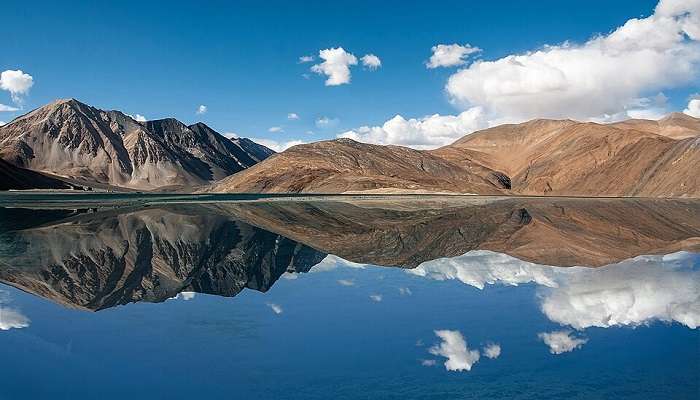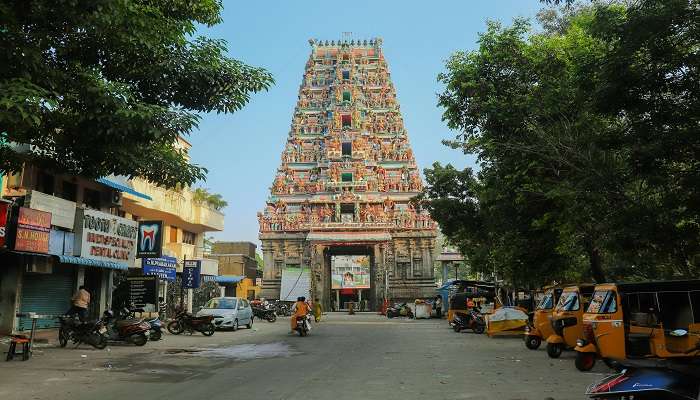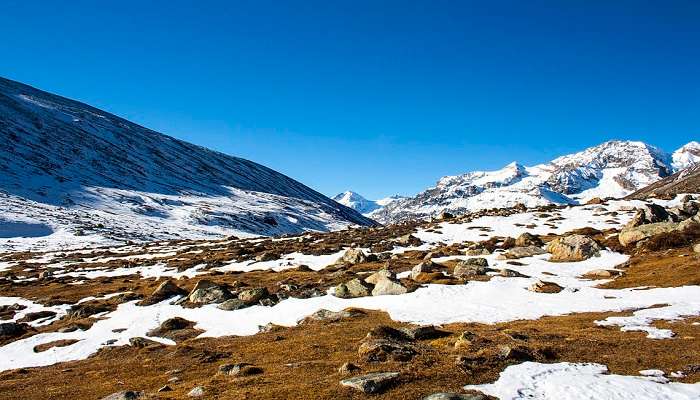Visit The Banjhakri Falls To Immerse In The Serene Oasis Of Nature In 2025
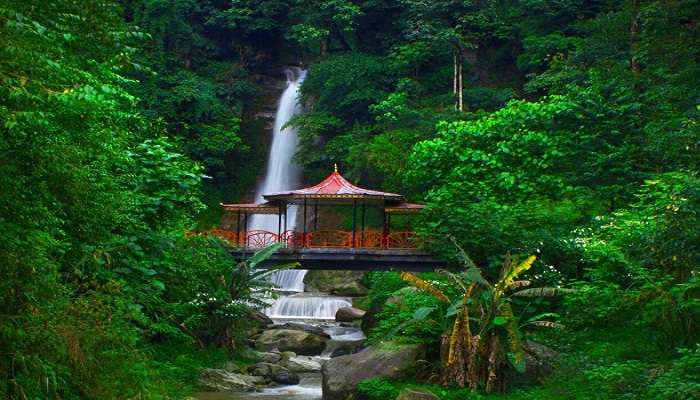
Located in Sikkim, Banjhakri Falls is a must-visit for tourists looking forward to exploring the best of nature and the state’s cultural heritage. This off-beat destination situated at a mere 7 kilometres from the capital town of Gangtok has much more to it than a mesmerising 40-foot-high waterfall. As you enter there are green foliage, pathways with beautiful bridges, and statues that narrate the story of Sikkim’s animistic culture. No matter your passion for nature, art, and archaeology or just seeking something peaceful, Banjhakri Falls will serve as a perfect retreat for you.
About Banjhakri Falls
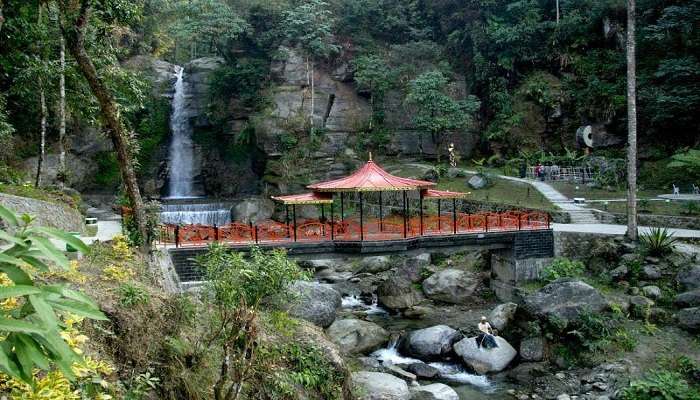
Banjhakri Falls is a 30-metre-high waterfall situated in Gangtok, Sikkim and it is developed in a two-acre theme park which was initiated by the Chief Minister Mr. Pawan Kumar Chamling. Established on a now deforested area of Sikkim, the park commemorates the culture of shamanism of the region. They include a man-made lake with a dragon, some over-damped gazebos, and sculptures of jhākri and Kirati forefathers. Artistic representations in the form of statues of different shamanistic characters are stored in wooden houses with thatched roofs.
The garden consists of lawns, shrubs, trees, flowers, walkways of concrete, chips, and gravel as well as mini bridges. One of the halls of the museum which has been arranged with the collaboration of SREDA presents renewable energy, which includes solar energy. The idea of the park is to remind people of the folk legends and beliefs while at the same time introducing them to the concepts of sustainable energy.
Also Read: Sikkim Travel Tips
Legend Of Banjhakri Falls
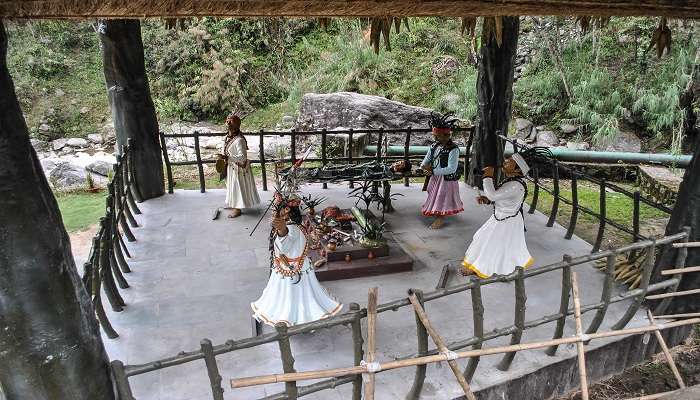
It is widely believed that Banjhakri Falls is a sacred place associated with the folklore of the Sikkimese, more precisely, the Kirati community. According to local history, it is connected to Jhakris—Indigenous ascetics who are considered spirits with healing and mystic powers. Such revered people are said to be able to talk with spirits who help balance nature and people’s lives.
The sculptures in the park represent the rites of shamans and initiation procedures. In Sikkimese architectural style, the park has two pavilions and a dragon-shaped lake which makes it serene. These are called Banjhakri Falls as they say that Banjhakri, a popular shaman, started meditating here. People living nearby regard this place as sacred and have faith that water from this waterfall has curative benefits and it contains Divine essence.
Banjhakri Falls Timings
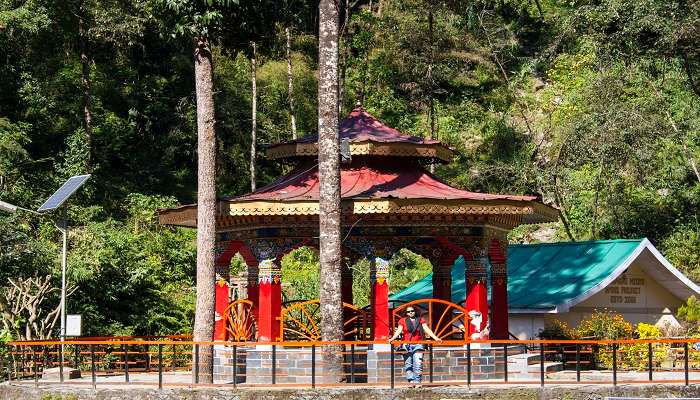
To make the most of your visit to Banjhakri Falls, it’s important to be aware of the timings. The falls are generally open to visitors from 8:00 AM to 5:00 PM, which allows ample time to explore the scenic beauty and cultural exhibits at the site. For the most accurate and up-to-date information, it’s always a good idea to check with local authorities or tour operators before planning your visit.
Related Post: Best Resorts in Sikkim
Best Time To Visit Banjhakri Falls
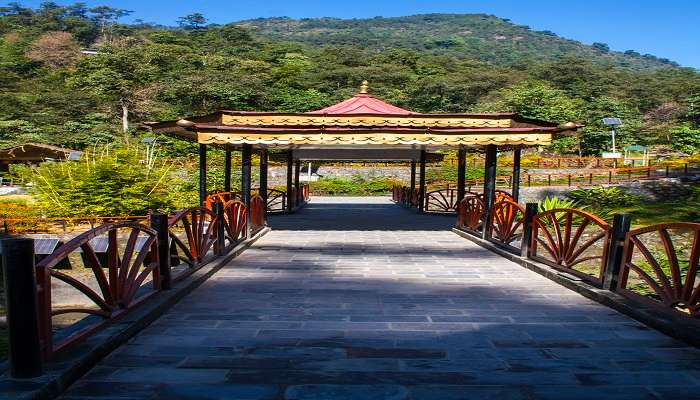
The optimal time to visit Banjhakri Falls is from October to February. Early winter months (October to November) offer a calm breeze and serene atmosphere. Late winter (February to March) provides a gentle climate with fewer tourists. Spring (March to June) and autumn (September to November) are also pleasant, with moderate temperatures and clear skies enhancing the natural beauty.
Tourist Attractions In Gangtok Near Banjhakri Falls
The area surrounding Banjhakri Falls in Gangtok has cultural and natural attractions. Visitors can explore various sites offering scenic views, spiritual experiences, and vibrant local culture. Here are some must-visit spots near Banjhakri Falls.
1. Ganesh Tok
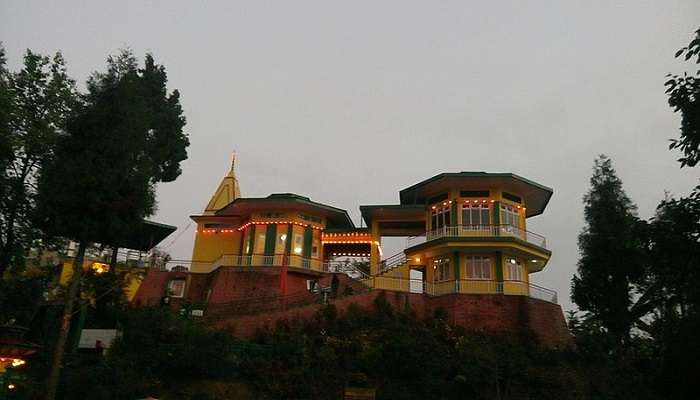
This famous Ganesh temple, on a small hill, is a famous tourist destination for people visiting Gangtok. Situated at an altitude of 2490 metres above sea level, It provides a panoramic view of the city and the hills of the Himalayas. This small shrine with hanging colourful prayer flags can be used to meditate or take beautiful pictures. The place offers a calm environment for those who want to view the stunning landscape. It is located on the roadside or a 10 to 15-minute’ walk from the road – consequently, it is a perfect spot for tourists interested in spirituality and nature.
Timings: 6:00 AM – 7:00 PM
Entry Fee: Free
Related Post: Places to Visit in Gangtok
2. Hanuman Tok
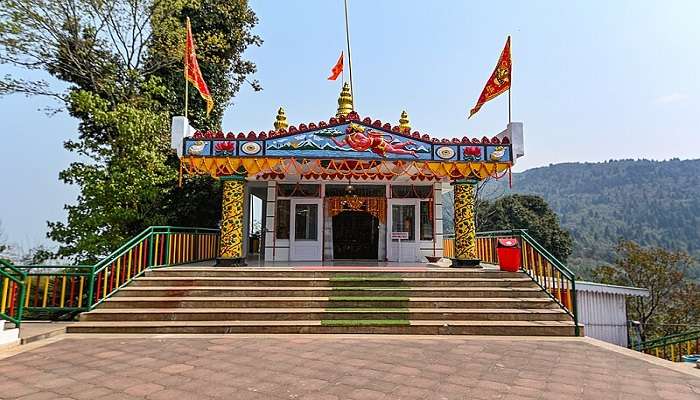
Located at 7,200 feet, Hanuman Tok is a famous Hindu shrine dedicated to Lord Hanuman. This unique spiritual centre has splendid panoramas of the Kanchenjunga mountains and valleys. Balinese art and architecture are used in the temple’s design, and the temple’s walls are full of beautiful paintings and carvings. It has been developed with a beautifully laid garden and resting sheds for relaxing. The site becomes even more attractive in the morning and at dusk when glancing at the mountains imbued with the warm golden colour.
Timings: 7:00 AM – 5:00 PM
Entry Fee: Free
3. MG Marg
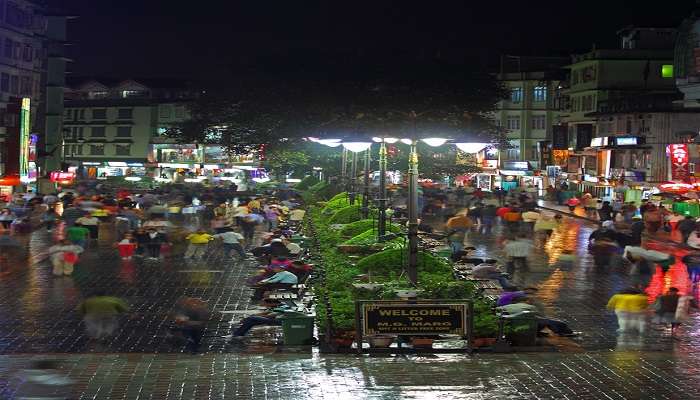
Mahatma Gandhi Road, familiarly known as MG Road, is Gangtok’s lifeline. This avenue for pedestrians consists of various types of shops, cafes, restaurants and hotels. They can also find local handicraft products, Sikkim’s ethnic dressing style products, and souvenir shops. Nightlife on the street is also active, with most of the people who live there and tourists who come to visit the place moving around. Some other attractions include- Street performers, music, and events. MG Marg is also cleaner with beautiful flowerbeds, thus making the stretch an ideal place for people to take a leisurely walk.
Timings: Open 24 hours
Entry Fee: Free
Related Post: Honeymoon In Sikkim
4. Tashi Viewpoint
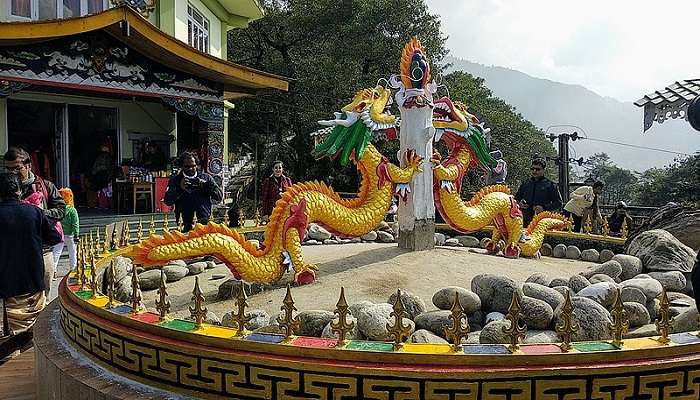
Located approximately at a distance of 8 km from the capital city of Gangtok, Tashi Viewpoint is the most renowned place for witnessing nature’s spectacle in full bloom. Depending on the weather, the visitors are provided an excellent view of Kanchenjunga with its snow-capped peaks and valleys. The viewpoint consists of a gazebo with sofa-like benches where people can relax and enjoy the view. As the sun rises, the peaks cast beautiful shadows on the plains, making early mornings the most beautiful times to visit. There is also a small cafe beside a souvenir shop that makes the site appropriate for a brief rest in between sightseeing.
Timings: 5:00 AM – 6:00 PM
Entry Fee: Free
5. Rumtek Monastery
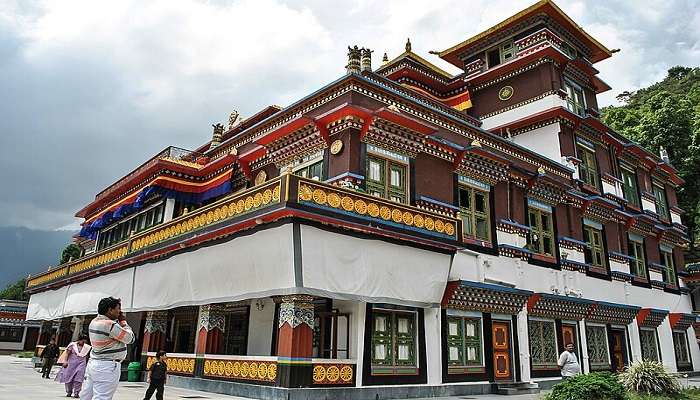
Rumtek Monastery, which is located 24 kms away from Gangtok, is perhaps one of the most famous monasteries in Sikkim. It was constructed in the 1960s and replicates the layout of the Tsurphu Monastery situated in Tibet. It forms a beautiful Tibetan architecture with stunning murals, unique sculptures, and other Buddhist items. It also contains the Golden Stupa and the relics of the 16th Karmapa, one of the significant attractions. Visitors can explore the main temple, meditation hall, and garden. It also holds vibrant religious ceremonies that offer a profound glimpse into Tibetan Buddhism’s rich cultural traditions.
Timings: 6:00 AM – 6:00 PM
Entry Fee: Free
Related Post: Places To Visit In North Sikkim
6. Ranka Monastery
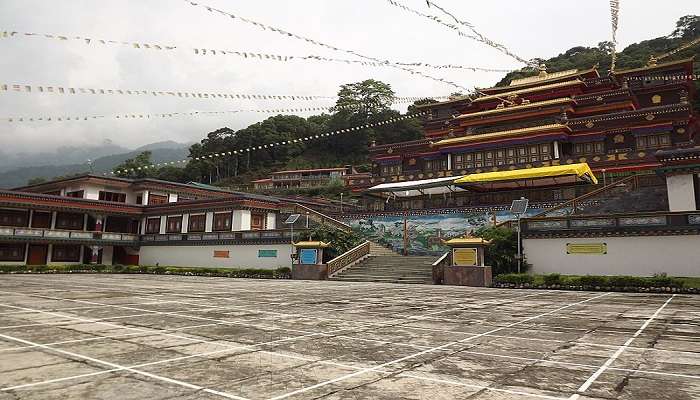
Known as Lingdum Monastery, Ranka Monastery is a calm and serene Tibetan Monastery situated about 20 kilometres from Gangtok. As a relatively new monastery in a green environment with forests and mountains, this place reveals exceptional workmanship and architectural design. Every part of the temple and its ornaments has relevance to the Buddhist religion. For example, the ceiling of the main temple hall has various murals of the Buddha and sacred teachings. The main attractions include strolling through the monasteries’ quiet gardens and watching the monks meditating. The stunning natural surroundings enhance the monastery’s appeal, making it an ideal destination for those seeking spiritual renewal.
Timings: 6:00 AM – 6:00 PM
Entry Fee: Free
How To Reach Banjhakri Water Falls In Gangtok

As a popular tourist attraction in Gangtok, Banjhakri Falls and Energy Park are easily accessible by various modes of transport. Below are different ways to reach Banjhakri Falls.
By Taxi: The most accessible route is from Gangtok by taxi. The falls are about 7 kilometres from the central business district, and it takes 20-30 minutes to get there. Taxis are easily found, and for $25, one can arrange for round-trip transportation.
By Car: Those who have their own transport can drive to Banjhakri Falls. The quickest way is by road, starting with the Gangtok main road and branching off to Banjhakri Falls Road. The directions are clear, and the path has features that one can admire while at it.
By Public Transport: To get to BS Charan, one can get into shared taxis or local buses bound for Banjhakri or any part of the neighbouring regions. Food in restaurants may be expensive, and eating places might be few compared to places that serve private cars.
You May Also Like To Read: Sikkim in December
When planning a trip to Sikkim, you should schedule a visit to Banjhakri Falls. This attractive place allows tourists to explore natural sights and cultural landmarks. From the charming waterfall to the fascinating museum and the amazing models in the Energy Park, every place here adds to your Sikkim visit.
For our editorial codes of conduct and copyright disclaimer, please click here.
Cover Image Source: Facebook
Frequently Asked Questions About Banjhakri Falls
What does one wear for a visit to Banjhakri Falls?
There is no rule you have to adhere to when it comes to dressing, but it is recommended that for the walks, one dresses in rather comfy, loose-fitting clothing along with appropriate shoes for slippery pathways.
Are there any food stalls in Banjhakri Falls?
There are only a few limited food substances you can find around the falls area but it is advisable to bring bottled water and snacks of your own.
Are Banjhakri Falls friendly for children or the elderly?
It is mainly a family park with paved paths, benches, and recreational facilities, however, some areas can be a bit problematic for persons with mobility impairment.
Is it allowed to swim in the waterfall or nearby pools?
Because of security concerns, swimming is prohibited in Banjhakri Falls but it is still a good place to catch a shower while viewing the falls from strategic vantage points.
Are there any guided tours in Banjhakri Falls?
Hired local guides are mostly available at the entrance of the falls who provide better information about the falls and the cultures of Sikkim.
People Also Read:
Unchalli Falls Kaigal Falls Devaragundi Falls

With a passion for exploring and travelling to the roads long forgotten, experience the world through enthralling stories and adventures. Join me as I share my experiences at some of the world’s most popular tourist destinations and quench that pestering curiosity with something exciting!



